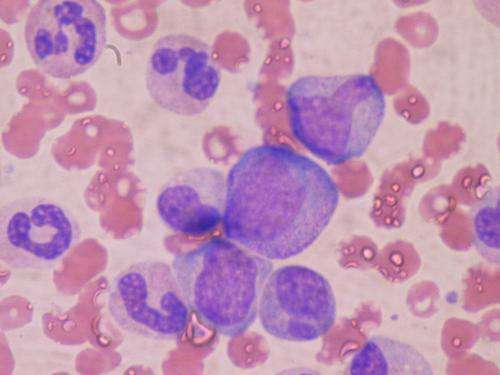Hematopoietic precursor cells: promyelocyte in the center, two metamyelocytes next to it and band cells from a bone marrow aspirate. Credit: Bobjgalindo/Wikipedia
One of the major obstacles in the treatment of pancreatic cancer is the defense wall that is formed around the tumor. This "desmoplastic stroma" prevents chemotherapy from reaching the tumor. Scientists of the University of Twente now found out which part of the stroma can best be attacked. Furthermore, they discovered a peptide than can serve as an attacker. In "Science Advances' they show that using the combination of the peptide and the cytostatics, tumor volume can be drastically reduced. In a few years, the first therapeutic studies may be done.
Pancreatic cancer is the cancer with the worst survival rates. After the—often late—diagnosis, most of the patients die within 3 to 4 months. Surgery for removing the tumor is, in many cases, not possible because of the risk of damaging other vital organs. Chemotherapy, using gemcitabine, often isn't successful, because the tumor cells are surrounded by fibroblasts and fibrous matrix network so-called desmoplastic stroma, that can be much bigger in size than the tumor cells nest itself.
Key element
Can we reduce the stroma and, first of all, find the key element that can be attacked? That was the question Jai Prakash and his team started with. After many comparative studies, a protein called integrin alpha 5, ITGA5 proved to be decisive in the survival rate of patients with pancreatic cancer.
For this, tumor tissues of ~140 patients were examined. Furthermore, with extensive biological experiments the team proved that attacking ITGA5 biologically would reduce the stroma and give a better access to the tumor. The next crucial question was: can we find a substance for effectively attacking ITGA5?
Eighty percent reduction
In their Science Advances paper, the researchers now discovered a short crucial sequence of seven amino acids, that is hidden in a large protein from our own body named fibronectin, of over 1000 amino acids, after laborious screening work. This sequence is named AV3 peptide and turned to be the best candidate for blocking ITGA5. First tests, with tumor tissue and stroma in a petri dish developed in three-dimensional culture, showed that tumor volume could be reduced after AV3 and gemcitabine were added. Tests with a human tumor inserted into a mouse also showed reduction of up to 80 percent of the tumor volume. Reducing the tumor in size, could already open the way for surgery. But according to Jai Prakash, higher doses of AV3 with cytostatics could even remove the tumor as a whole.
Before testing this on humans, it is necessary to determine the response of healthy humans on AV3. Until now, there are no signs of toxicity. After AV3 proves to be safe, there will be a procedure for approval, followed by clinical trials using both AV3 and cytostatics. Jai Prakash patented the peptide and started a company called ScarTec Therapeutics, with Dutch Research Council (NWO-TTW) and EU support, for accelerating the introduction of the new type of medication. ScarTec is actively seeking investment for the development of this peptide to reach patients in the near future. Jai Prakash says that if the required investment is successfully acquired, the first in-man study is expected in 2021 while the therapeutic studies in patients can start in 2022-2023.
More information: Praneeth R. Kuninty et al. ITGA5 inhibition in pancreatic stellate cells attenuates desmoplasia and potentiates efficacy of chemotherapy in pancreatic cancer, Science Advances (2019). DOI: 10.1126/sciadv.aax2770
Journal information: Science Advances
Provided by University of Twente























